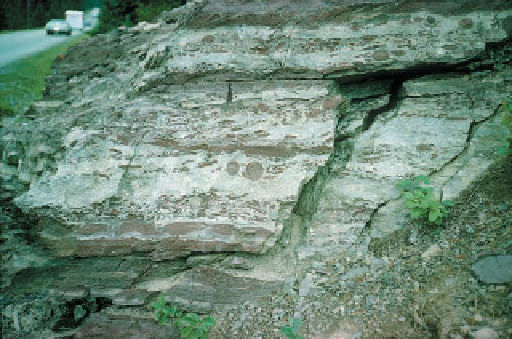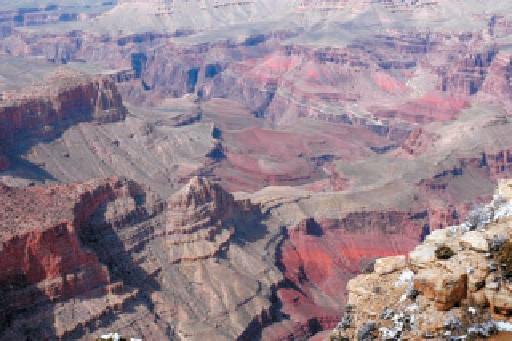Geology Reference
In-Depth Information
b
This 1.0-billion-year-old sandstone in Glacier National Park in
Montana has been slightly altered by metamorphism.
a
Meso- to Neoproterozoic sedimentary basins in western
North America.
c
Sandstone in the Grand Canyon of Arizona. The reddish color
results from the presence of small amounts of iron oxides.
◗
Figure 19.13
Proterozoic Rocks in the West
atmosphere and end the glacial episode. In fact, proponents
of this hypothesis note that several such snowball Earths
may have occurred until the continents moved into higher
latitudes. One criticism of the hypothesis is that if all land
was ice covered and the sea froze, how would life survive?
Several suggestions have been made to account for this—life
persisted at hydrothermal vents on the seafl oor; even pho-
tosynthesis can take place beneath thin glacial ice; perhaps
life persisted in subglacial lakes as it does now in Antarctica;
and there may have been pools of liquid water near active
volcanoes.
meters thick, but those of Proterozoic age are much thicker,
cover vast areas, and were probably deposited in shallow
marine environments. About 92% of all BIFs formed during
the interval from 2.5 to 2.0 billion years ago, that is, during
the earlier part of the Paleoproterozoic.
Iron is a highly reactive element that in the presence of
oxygen forms rustlike oxides that do not readily dissolve in
water. If free oxygen is absent, though, iron goes into solution
and accumulates in the oceans. Given that the Archean atmo-
sphere had little free oxygen, abundant iron was dissolved in
seawater. About 2.3 billion years ago, however, there was an
increase in the abundance of photosynthesizing bacteria, a
corresponding increase in the amount of free oxygen in the
atmosphere and oceans, and the precipitation of iron and
silica to form BIFs.
Banded Iron Formation
In Chapter 5, we briefl y discussed
the sedimentary rock known as
banded iron formations
(BIFs)
that consist of alternating thin layers of silica (chert)
and the iron oxide minerals hematite (Fe
2
O
3
) and magnetite
(Fe
3
O
4
) (
Continental Red Beds
Obviously, the term
continen-
tal red beds
refers to red rocks on the continents; however,
Figure 19.16). Archean-age BIFs are small lens-
shaped bodies measuring a few kilometers across and a few
◗





Search WWH ::

Custom Search